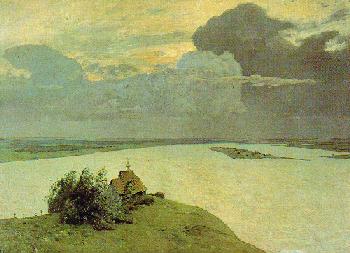
Oil on canvas, 150 x 206 cm. Tretiakov Gallery, Moscow.

 In Above Eternal Peace Levitan has created an image so beautiful
and so memorable that it would be difficult to dismiss it lightly as just
another landscape painting. As much as painting an image of the Russian
land, Levitan evokes a mood of peace and tranquility that becomes inseparable
from the idea of space and freedom, and from the universal quality of beauty
and art. Benois said that Levitan "felt that Nature lives and praises the
Creator," and no painting expresses this sentiment quite like Above
Eternal Peace.
In Above Eternal Peace Levitan has created an image so beautiful
and so memorable that it would be difficult to dismiss it lightly as just
another landscape painting. As much as painting an image of the Russian
land, Levitan evokes a mood of peace and tranquility that becomes inseparable
from the idea of space and freedom, and from the universal quality of beauty
and art. Benois said that Levitan "felt that Nature lives and praises the
Creator," and no painting expresses this sentiment quite like Above
Eternal Peace.
The composition of this painting is both aesthetically affective (with its irregularly shaped divisions of the picture plane and clear center of focus) and symbolically effective. While the graveyard (to the left of the church) may symbolize death, the church itself (as the focal point of the painting) seems to whisper that there is another way – a way to live – and this way is through Jesus and the divine plan God implemented through his birth, death, and resurrection. The still plane of water behind the church emphasizes this idea and the peace granted to those who accept it. This entire image asserts the strength of not so much the Russian Orthodox Church, but the beliefs it represents. In this way, and in the pride of countryside so beautiful and so lyrical, does this painting express the beliefs and aims of the Russian Revival of the late 19th century, and serve as a fine example of the "deeply poetic vision" Levitan achieved in his art. [C.B.]
